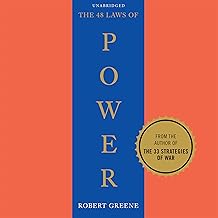
How to Read Robert Greene's Books on Manipulation
How to Read Robert Greene's Books on Manipulation
Estimated Reading Time: 10-12 minutes
Introduction
Robert Greene, an American author and speaker, has become synonymous with the exploration of power dynamics and manipulation in human relationships. Born in 1966 in Los Angeles, Greene's diverse background in classical studies and various jobs—from construction to writing—has deeply informed his understanding of human behavior. His works, particularly "The 48 Laws of Power" and "The Art of Seduction," delve into the intricate strategies individuals employ to influence, control, and seduce others.
Greene's perspective on manipulation is unique in that it combines historical anecdotes, psychological insights, and practical applications, making his ideas not just theoretical but also actionable. In a world where interpersonal dynamics are increasingly complex, his writings provide valuable tools for navigating social landscapes. This guide will explore the main themes and insights from Greene's works, offering a comprehensive understanding of manipulation through his lens.
Why Robert Greene's Perspective Matters
What sets Robert Greene apart from other thinkers is his unflinching approach to the darker aspects of human nature. While many self-help and motivational authors focus on positivity and ethical behavior, Greene acknowledges that manipulation is a fundamental part of human interaction. His insights are grounded in historical examples, making them both relatable and relevant.
Greene's contributions to the discourse on manipulation are significant because they challenge readers to confront uncomfortable truths about power and influence. His works encourage critical thinking about morality and ethics in the context of personal and professional relationships. By understanding manipulation, readers can better navigate their own lives, whether to protect themselves or to achieve their goals.
Overview of Recommended Books
The 48 Laws of Power
"The 48 Laws of Power" is perhaps Greene's most famous work, offering a pragmatic guide to gaining and maintaining power. The book is structured around 48 laws, each illustrated with historical examples and anecdotes from figures such as Machiavelli, Sun Tzu, and various political leaders. The main themes revolve around deception, strategy, and the often ruthless nature of power dynamics.
Key Insights:
- Law 1: Never Outshine the Master - Always make those above you feel superior. This law emphasizes the importance of humility in power dynamics.
- Law 3: Conceal Your Intentions - Keeping your plans secret can prevent others from sabotaging your efforts. This insight is crucial in competitive environments.
- Law 15: Crush Your Enemy Totally - Greene argues that leaving no room for retaliation is essential in power struggles. This law highlights the importance of decisiveness.
- Law 48: Assume Formlessness - Adaptability is key to survival in power plays. This principle encourages flexibility in strategy and approach.
Why Read This Book: "The 48 Laws of Power" is essential for anyone seeking to understand the mechanics of influence and manipulation. It is particularly beneficial for professionals in competitive fields, as well as individuals looking to enhance their social skills. Greene's work serves as a manual for recognizing and countering manipulation in others, ultimately leading to greater self-awareness and empowerment.
The Art of Seduction
In "The Art of Seduction," Greene shifts his focus from power to the subtleties of attraction and persuasion. The book categorizes different types of seducers and outlines the strategies they employ to captivate and manipulate others. Greene's exploration of seduction is not limited to romantic contexts; it also applies to social and professional interactions.
Key Insights:
- The Seductive Character - Greene identifies nine archetypes of seducers, such as the Siren and the Rake. Understanding these types can help individuals identify their own seductive traits.
- Create a False Sense of Security - By making others feel comfortable, you can lower their defenses and increase your influence over them. This insight is particularly relevant in building trust.
- Master the Art of Indirection - Subtlety is key in seduction. Greene advocates for a less direct approach, allowing the other person to feel they are in control.
- Use the Power of Words - Language can be a powerful tool for seduction. Greene emphasizes the importance of storytelling and charm in captivating others.
Why Read This Book: "The Art of Seduction" is invaluable for anyone interested in the dynamics of attraction and interpersonal influence. It offers practical strategies for enhancing charisma and social skills, making it particularly useful for professionals in sales, marketing, and the arts. Greene's insights into human psychology can help readers navigate complex social situations with greater finesse.
How These Books Complement Each Other
While "The 48 Laws of Power" and "The Art of Seduction" focus on different aspects of manipulation, they are deeply interconnected. Both works explore the underlying principles of influence, albeit through different lenses—one through the lens of power and the other through attraction. Together, they provide a comprehensive understanding of manipulation, illustrating how power dynamics can manifest in various forms of relationships.
Reading these books in tandem allows for a deeper appreciation of the complexities of human interaction. Greene's exploration of power equips readers with the tools to navigate competitive environments, while his insights into seduction enhance interpersonal skills and emotional intelligence. Together, they form a holistic approach to understanding manipulation.
Who Would Benefit from Reading These Books
The ideal readers for Greene's works include:
- Students and Academics: Those studying psychology, sociology, or political science will find Greene's insights applicable to their fields.
- General Readers Interested in Manipulation: Anyone curious about human behavior and social dynamics will benefit from Greene's accessible writing style and practical applications.
- Professionals Seeking Practical Wisdom: Individuals in sales, management, or leadership roles can apply Greene's strategies to enhance their influence and effectiveness.
- Anyone Looking for Personal Growth and Self-Improvement: Greene's works encourage self-reflection and awareness, making them valuable for personal development.
Recommended Reading Order
- Start with: The 48 Laws of Power - This foundational text provides essential insights into power dynamics and manipulation, setting the stage for understanding broader themes.
- Continue with: The Art of Seduction - This book builds on the principles of influence, focusing on attraction and interpersonal relationships, making it a natural progression after understanding power.
- Advanced Reading: The 33 Strategies of War - For those seeking a deeper dive into strategic thinking and manipulation in competitive contexts, this book expands on Greene's core themes.
To get the most out of each book, consider taking notes on key insights and reflecting on how they apply to your own experiences. Engage with the historical examples Greene provides to see the practical applications of his ideas.
Conclusion
Robert Greene's contributions to the theme of manipulation are both profound and timely. His exploration of power and seduction offers readers a nuanced understanding of human behavior and interpersonal dynamics. By engaging with Greene's works, readers can develop critical skills for navigating their social and professional lives, empowering them to achieve their goals while remaining aware of the ethical implications of manipulation.
As you embark on this journey through Greene's writings, remember that the insights gained are not merely tools for manipulation but also keys to understanding the intricate tapestry of human relationships. Dive into these works, reflect on their teachings, and consider how they can enrich your life and interactions with others.
Tags: #RobertGreene #Manipulation #Philosophy #ReadingGuide #ClassicLiterature #Wisdom
Featured Books

The 48 Laws of Power
by Robert Greene
Published: 1998
Amoral, cunning, ruthless, and instructive, this multi-million-copy New York Times bestseller is the definitive manual for anyone interested in gaining, observing, or defending against ultimate control – from the author of The Laws of Human Nature. This is the only authorized paperback edition in the US. In the book that People magazine proclaimed “beguiling” and “fascinating,” Robert Greene and Joost Elffers have distilled three thousand years of the history of power into 48 essential laws by drawing from the philosophies of Machiavelli, Sun Tzu, and Carl Von Clausewitz and also from the lives of figures ranging from Henry Kissinger to P.T. Barnum. Some laws teach the need for prudence (“Law 1: Never Outshine the Master”), others teach the value of confidence (“Law 28: Enter Action with Boldness”), and many recommend absolute self-preservation (“Law 15: Crush Your Enemy Totally”). Every law, though, has one thing in common: an interest in total domination. In a bold and arresting two-color package, The 48 Laws of Power is ideal whether your aim is conquest, self-defense, or simply to understand the rules of the game. Read more

The Art of Seduction
by Robert Greene
Published: 2001
From the author of the multi-million copy bestseller The 48 Laws of Power and The Laws of Human Nature, a mesmerizing handbook on seduction: the most subtle and effective form of power. This is the only authorized paperback edition in the US. When raised to the level of art, seduction, an indirect and subtle form of power, has toppled empires, won elections and enslaved great minds. Immerse yourself in the twenty-four maneuvers and strategies of the seductive process, the ritual by which a seducer gains mastery over his target. Understand how to "Poeticize Your Presence," “Keep them in Suspense – What Comes Next” and “Master the Art of the Bold Move”. Every bit as essential as The 48 Laws of Power, The Art of Seduction is an indispensable primer of persuasion that reveals one of history's greatest weapons and the ultimate form of power. Read more